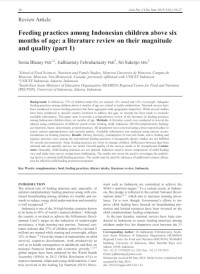Feeding practices among Indonesian children above six months of age: a literature review on their magnitude and quality (part 1)

Author
Judhiastuty Februhartanty - Personal NameSonia Blaney - Personal Name
Sri Sukotjo - Personal Name
Abstract:
Background: In Indonesia, 37% of children under-five are stunted, 12% wasted and 12% overweight. Adequate feeding practices among children above 6 months of age are critical to tackle malnutrition. National surveys have been conducted to assess feeding practices but these aggregates hide geographic disparities. While several studies have been conducted in specific country locations to address this gap, no attempt has been made to reconcile available information. This paper aims to provide a comprehensive review of the literature on feeding practices among Indonesian children above six months of age. Methods: A literature search was conducted in several databases using combinations of different search terms: feeding, child, Indonesia, MPASI/complementary feeding, gizi/nutrition, factor, determinant, praktek/practices. All documents were reviewed using a three-step procedure to assess content appropriateness and research quality. Available information was analyzed using current recommendations on feeding practices. Results: Dietary diversity, consumption of iron-rich foods, active feeding and hygiene practices were among the non-optimal feeding practices. Consequently dietary intakes are not fulfilled for several micronutrients. Some feeding practices are worst in younger children. Differences between data from national and site-specific surveys are noted. Overall quality of the surveys needs to be strengthened. Conclusions: Generally, child feeding practices are not optimal. Indicators used to assess components of child feeding vary and make inter-survey comparisons challenging. The results also stress the need to investigate the underlying factors to optimal child feeding practices. The results may be used for advocacy of additional resource allocation for effective child feeding promotion programs.
Detail Information
| Series Title | : | - |
| Call Number | : | - |
| Publisher | : | Asia Pac J Clin Nutr : ., 2015 |
| Collation | : | Asia Pac J Clin Nutr . 2015;24(1):16-2 |
| Language | : | English |
| ISBN/ISSN | : | - |
| Classification | : | NONE |
 Computer Science, Information & General Works
Computer Science, Information & General Works  Philosophy & Psychology
Philosophy & Psychology  Religion
Religion  Social Sciences
Social Sciences  Language
Language  Pure Science
Pure Science  Applied Sciences
Applied Sciences  Art & Recreation
Art & Recreation  Literature
Literature  History & Geography
History & Geography